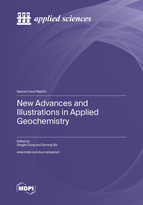New Advances and Illustrations in Applied Geochemistry
A special issue of Applied Sciences (ISSN 2076-3417). This special issue belongs to the section "Earth Sciences".
Deadline for manuscript submissions: closed (1 July 2023) | Viewed by 20346
Special Issue Editors
Interests: exploration; weathering; elemental behaviors
Special Issues, Collections and Topics in MDPI journals
Interests: geochemistry; environment; soil; mine; water sediment
Special Issues, Collections and Topics in MDPI journals
Special Issue Information
Dear Colleagues,
The 9th national conference on applied geochemistry in China will be held in Chengdu, Sichuan province, on 28-31 October and hosted by the committee of applied geochemistry, Chinese Society for Mineralogy, Petrology and Geochemistry (CSMPG). This dedicated Special Issue is being organized to facilitate academic exchange on applied geochemistry through the presentation of new advances and case illustrations in this field.
This Special Issue will publish high-quality original research papers covering the following topics:
- Geochemical exploration and resource geochemistry;
- Geochemical survey and environmental geochemistry;
- Agricultural and ecological geochemistry;
- Geochemistry of geological disaster response;
- Applied geochemistry in other social services.
- Big data in applied geochemistry.
Prof. Dr. Qingjie Gong
Prof. Dr. Zeming Shi
Guest Editors
Manuscript Submission Information
Manuscripts should be submitted online at www.mdpi.com by registering and logging in to this website. Once you are registered, click here to go to the submission form. Manuscripts can be submitted until the deadline. All submissions that pass pre-check are peer-reviewed. Accepted papers will be published continuously in the journal (as soon as accepted) and will be listed together on the special issue website. Research articles, review articles as well as short communications are invited. For planned papers, a title and short abstract (about 100 words) can be sent to the Editorial Office for announcement on this website.
Submitted manuscripts should not have been published previously, nor be under consideration for publication elsewhere (except conference proceedings papers). All manuscripts are thoroughly refereed through a single-blind peer-review process. A guide for authors and other relevant information for submission of manuscripts is available on the Instructions for Authors page. Applied Sciences is an international peer-reviewed open access semimonthly journal published by MDPI.
Please visit the Instructions for Authors page before submitting a manuscript. The Article Processing Charge (APC) for publication in this open access journal is 2400 CHF (Swiss Francs). Submitted papers should be well formatted and use good English. Authors may use MDPI's English editing service prior to publication or during author revisions.
Keywords
- resource prospecting
- ecological risk assessment
- elemental and isotopic weathering behaviors
- source tracing







